Data Mining in Retail E-commerce
VerifiedAdded on 2019/09/13
|13
|4079
|370
Literature Review
AI Summary
This literature review explores the application of data mining in the retail e-commerce sector. It begins by defining data mining and its various categories, such as visualization, predictive modeling, and link analysis. The review then delves into how data mining is used in marketing to identify target customers and improve customer relations through cross-selling and up-selling strategies. The paper further examines the use of data mining in e-commerce, focusing on how online data sources can be used to enhance marketing strategies, improve website design, and personalize customer experiences. The review also discusses the challenges associated with data mining, such as translating business questions into data transformations and ensuring algorithm efficiency. The conclusion emphasizes the benefits of data mining for e-commerce businesses, highlighting its role in customer assessment, prediction, and decision-making, despite the challenges of managing large datasets.

Data Mining in Retail
(with focus on e-commerce)
Student Name:
Student ID:
Course Name:
Course ID:
Faculty Name:
University Name:
(with focus on e-commerce)
Student Name:
Student ID:
Course Name:
Course ID:
Faculty Name:
University Name:
Paraphrase This Document
Need a fresh take? Get an instant paraphrase of this document with our AI Paraphraser

Introduction
The current paper will review various literatures developed by researchers from around the
world. The focus would be to understand the aspects of data mining and its close association
with retail industry. The retail e-ecommerce will be under consideration. The current paper
has been divided into three key chapters. The first chapter will focus on understanding the
various aspects of data mining. The second chapter will focus on understanding data mining
in context of marketing. Marketing is a highly relevant field to the ecommerce business and it
is suggested to understand what has been said on this area with prime focus on data mining.
The third chapter discusses data mining considering the ecommerce business. In the end, a
conclusive remark has been given. Data mining, if utilized effectively, is likely to improve
the businesses to greater heights.
Understanding Data Mining
Data mining has now become talk of the town and the organizations have realized that it can
be of great advantage to them. Data mining can allow the organizations to collect and analyse
huge amount of data and stay ahead of the competition (Witten et al, 2016). The important
and beneficial aspect of adoption of data mining is the availability of data, which has
increased substantially in the past few years. Now the companies are in situation where they
generate tons of data and have no idea on how to use those data to make informed decision
making (Hall et al, 2013). Moreover, the adoption of data mining should not be for the reason
that availability of data is increased, it should be for the reason that the advancement in the
technology such machine learning and decreased cost of computing capability has increased
the ease with which the organizations can understand their customers, competitors, and
The current paper will review various literatures developed by researchers from around the
world. The focus would be to understand the aspects of data mining and its close association
with retail industry. The retail e-ecommerce will be under consideration. The current paper
has been divided into three key chapters. The first chapter will focus on understanding the
various aspects of data mining. The second chapter will focus on understanding data mining
in context of marketing. Marketing is a highly relevant field to the ecommerce business and it
is suggested to understand what has been said on this area with prime focus on data mining.
The third chapter discusses data mining considering the ecommerce business. In the end, a
conclusive remark has been given. Data mining, if utilized effectively, is likely to improve
the businesses to greater heights.
Understanding Data Mining
Data mining has now become talk of the town and the organizations have realized that it can
be of great advantage to them. Data mining can allow the organizations to collect and analyse
huge amount of data and stay ahead of the competition (Witten et al, 2016). The important
and beneficial aspect of adoption of data mining is the availability of data, which has
increased substantially in the past few years. Now the companies are in situation where they
generate tons of data and have no idea on how to use those data to make informed decision
making (Hall et al, 2013). Moreover, the adoption of data mining should not be for the reason
that availability of data is increased, it should be for the reason that the advancement in the
technology such machine learning and decreased cost of computing capability has increased
the ease with which the organizations can understand their customers, competitors, and
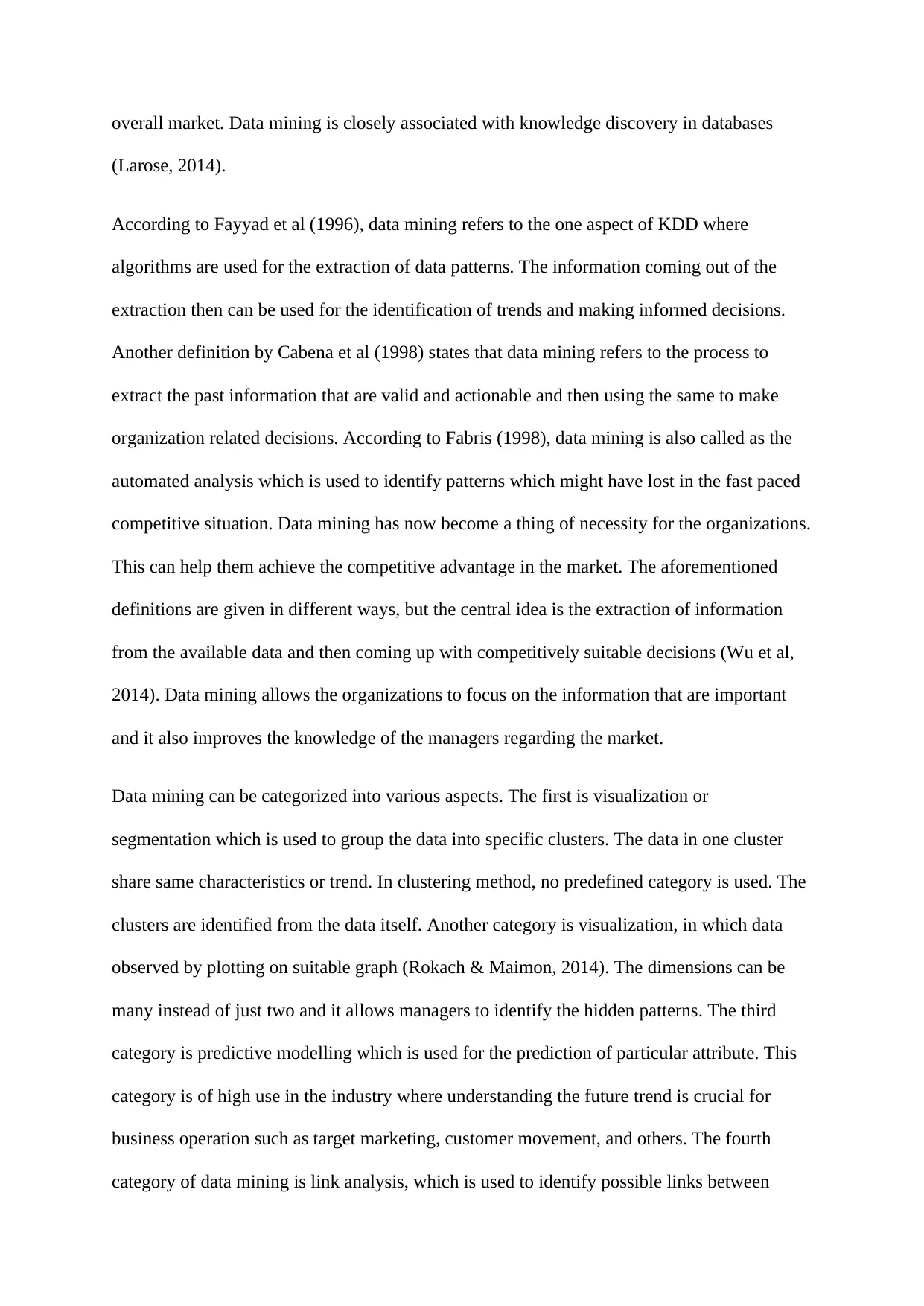
overall market. Data mining is closely associated with knowledge discovery in databases
(Larose, 2014).
According to Fayyad et al (1996), data mining refers to the one aspect of KDD where
algorithms are used for the extraction of data patterns. The information coming out of the
extraction then can be used for the identification of trends and making informed decisions.
Another definition by Cabena et al (1998) states that data mining refers to the process to
extract the past information that are valid and actionable and then using the same to make
organization related decisions. According to Fabris (1998), data mining is also called as the
automated analysis which is used to identify patterns which might have lost in the fast paced
competitive situation. Data mining has now become a thing of necessity for the organizations.
This can help them achieve the competitive advantage in the market. The aforementioned
definitions are given in different ways, but the central idea is the extraction of information
from the available data and then coming up with competitively suitable decisions (Wu et al,
2014). Data mining allows the organizations to focus on the information that are important
and it also improves the knowledge of the managers regarding the market.
Data mining can be categorized into various aspects. The first is visualization or
segmentation which is used to group the data into specific clusters. The data in one cluster
share same characteristics or trend. In clustering method, no predefined category is used. The
clusters are identified from the data itself. Another category is visualization, in which data
observed by plotting on suitable graph (Rokach & Maimon, 2014). The dimensions can be
many instead of just two and it allows managers to identify the hidden patterns. The third
category is predictive modelling which is used for the prediction of particular attribute. This
category is of high use in the industry where understanding the future trend is crucial for
business operation such as target marketing, customer movement, and others. The fourth
category of data mining is link analysis, which is used to identify possible links between
(Larose, 2014).
According to Fayyad et al (1996), data mining refers to the one aspect of KDD where
algorithms are used for the extraction of data patterns. The information coming out of the
extraction then can be used for the identification of trends and making informed decisions.
Another definition by Cabena et al (1998) states that data mining refers to the process to
extract the past information that are valid and actionable and then using the same to make
organization related decisions. According to Fabris (1998), data mining is also called as the
automated analysis which is used to identify patterns which might have lost in the fast paced
competitive situation. Data mining has now become a thing of necessity for the organizations.
This can help them achieve the competitive advantage in the market. The aforementioned
definitions are given in different ways, but the central idea is the extraction of information
from the available data and then coming up with competitively suitable decisions (Wu et al,
2014). Data mining allows the organizations to focus on the information that are important
and it also improves the knowledge of the managers regarding the market.
Data mining can be categorized into various aspects. The first is visualization or
segmentation which is used to group the data into specific clusters. The data in one cluster
share same characteristics or trend. In clustering method, no predefined category is used. The
clusters are identified from the data itself. Another category is visualization, in which data
observed by plotting on suitable graph (Rokach & Maimon, 2014). The dimensions can be
many instead of just two and it allows managers to identify the hidden patterns. The third
category is predictive modelling which is used for the prediction of particular attribute. This
category is of high use in the industry where understanding the future trend is crucial for
business operation such as target marketing, customer movement, and others. The fourth
category of data mining is link analysis, which is used to identify possible links between
⊘ This is a preview!⊘
Do you want full access?
Subscribe today to unlock all pages.

Trusted by 1+ million students worldwide
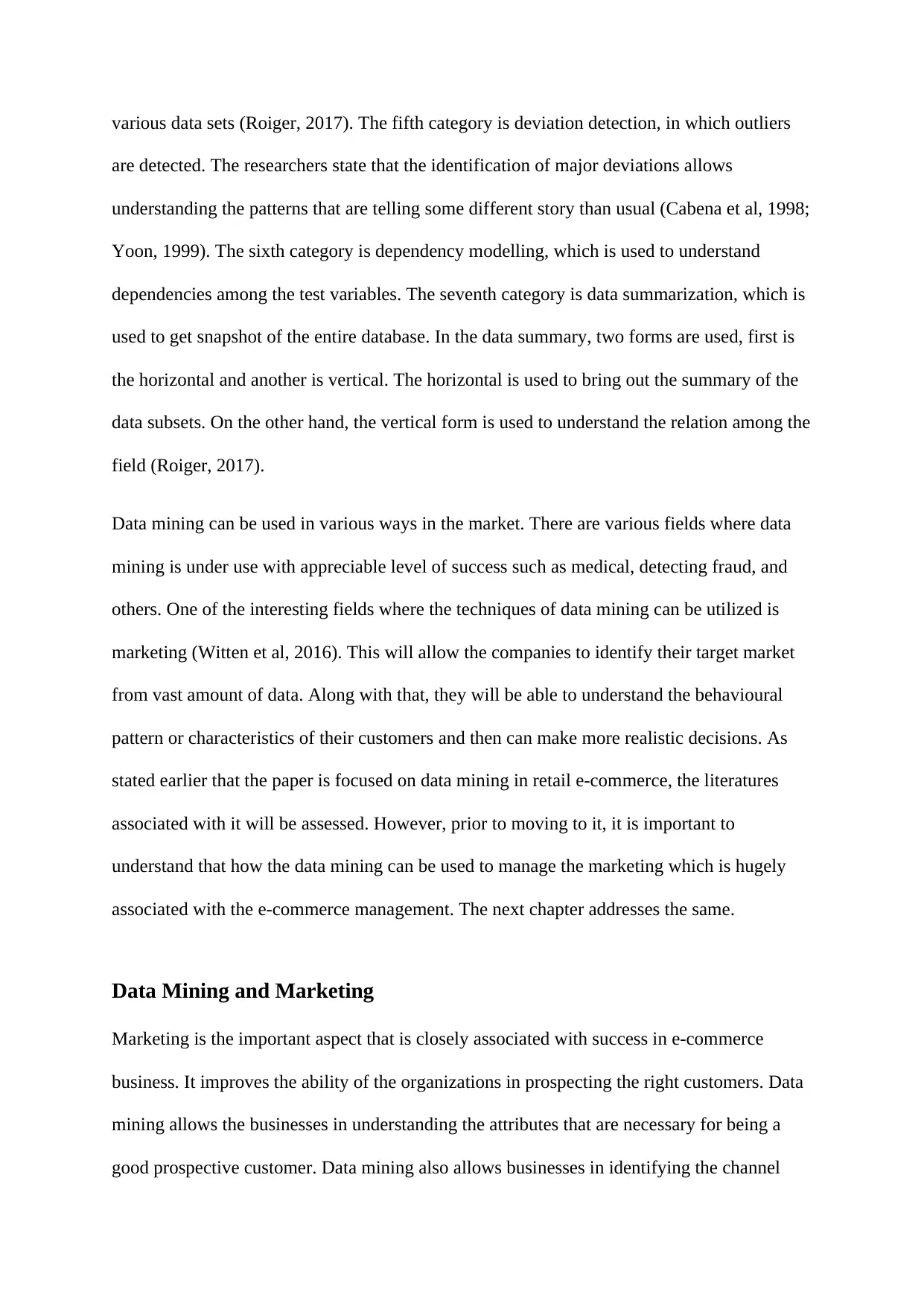
various data sets (Roiger, 2017). The fifth category is deviation detection, in which outliers
are detected. The researchers state that the identification of major deviations allows
understanding the patterns that are telling some different story than usual (Cabena et al, 1998;
Yoon, 1999). The sixth category is dependency modelling, which is used to understand
dependencies among the test variables. The seventh category is data summarization, which is
used to get snapshot of the entire database. In the data summary, two forms are used, first is
the horizontal and another is vertical. The horizontal is used to bring out the summary of the
data subsets. On the other hand, the vertical form is used to understand the relation among the
field (Roiger, 2017).
Data mining can be used in various ways in the market. There are various fields where data
mining is under use with appreciable level of success such as medical, detecting fraud, and
others. One of the interesting fields where the techniques of data mining can be utilized is
marketing (Witten et al, 2016). This will allow the companies to identify their target market
from vast amount of data. Along with that, they will be able to understand the behavioural
pattern or characteristics of their customers and then can make more realistic decisions. As
stated earlier that the paper is focused on data mining in retail e-commerce, the literatures
associated with it will be assessed. However, prior to moving to it, it is important to
understand that how the data mining can be used to manage the marketing which is hugely
associated with the e-commerce management. The next chapter addresses the same.
Data Mining and Marketing
Marketing is the important aspect that is closely associated with success in e-commerce
business. It improves the ability of the organizations in prospecting the right customers. Data
mining allows the businesses in understanding the attributes that are necessary for being a
good prospective customer. Data mining also allows businesses in identifying the channel
are detected. The researchers state that the identification of major deviations allows
understanding the patterns that are telling some different story than usual (Cabena et al, 1998;
Yoon, 1999). The sixth category is dependency modelling, which is used to understand
dependencies among the test variables. The seventh category is data summarization, which is
used to get snapshot of the entire database. In the data summary, two forms are used, first is
the horizontal and another is vertical. The horizontal is used to bring out the summary of the
data subsets. On the other hand, the vertical form is used to understand the relation among the
field (Roiger, 2017).
Data mining can be used in various ways in the market. There are various fields where data
mining is under use with appreciable level of success such as medical, detecting fraud, and
others. One of the interesting fields where the techniques of data mining can be utilized is
marketing (Witten et al, 2016). This will allow the companies to identify their target market
from vast amount of data. Along with that, they will be able to understand the behavioural
pattern or characteristics of their customers and then can make more realistic decisions. As
stated earlier that the paper is focused on data mining in retail e-commerce, the literatures
associated with it will be assessed. However, prior to moving to it, it is important to
understand that how the data mining can be used to manage the marketing which is hugely
associated with the e-commerce management. The next chapter addresses the same.
Data Mining and Marketing
Marketing is the important aspect that is closely associated with success in e-commerce
business. It improves the ability of the organizations in prospecting the right customers. Data
mining allows the businesses in understanding the attributes that are necessary for being a
good prospective customer. Data mining also allows businesses in identifying the channel
Paraphrase This Document
Need a fresh take? Get an instant paraphrase of this document with our AI Paraphraser

that will be more beneficial in using to target the customers (Tirunillai & Tellis, 2014). The
important thing about data mining is that it assesses the past data and help the company
understand what kind of customers reached for its product in the past few years. This will
give it list of few attributes that will be common to all the customers. At this point, with the
help of data mining, the companies can come up with list of potential customers who reflect
similar attributes (Heinmann, 2016). In addition to this, with the use of past data, the
company will also be able to understand the channels of communication that were preferred
by previous customers. This information can be used to reach the customers through most
preferred channels.
The management of customer relations is important for any business organizations. It allows
the businesses to build relationships with the customers that are long term and profitable. The
use of customer data and the advanced technologies can be used to aid in the better
management of the customers. There are two important elements in sales and marketing,
called cross selling, and up selling. These are the expected output by the companies when
they build relationship with the customers (Shmueli et al, 2016). It can be understood
considering one of the live case studies. Charles Schwab is an investment company. During
its operation, the company identified that its customers open their bank accounts with few
thousand dollars and then they rarely make efforts to put some money in the account even if
they hold large sums of money at other places. This led the company to score the past data.
The assessment of the historical data led the company identify that whoever has transferred
large amount to the account has done in the first few months. This led the company to change
their strategy for the customer attraction. Instead of making promotions throughout the year,
the company started focusing aggressively on first few months.
In general, the major challenge that is facing towards the companies is customer attrition.
Understanding this becomes far more important when the companies are operating in an
important thing about data mining is that it assesses the past data and help the company
understand what kind of customers reached for its product in the past few years. This will
give it list of few attributes that will be common to all the customers. At this point, with the
help of data mining, the companies can come up with list of potential customers who reflect
similar attributes (Heinmann, 2016). In addition to this, with the use of past data, the
company will also be able to understand the channels of communication that were preferred
by previous customers. This information can be used to reach the customers through most
preferred channels.
The management of customer relations is important for any business organizations. It allows
the businesses to build relationships with the customers that are long term and profitable. The
use of customer data and the advanced technologies can be used to aid in the better
management of the customers. There are two important elements in sales and marketing,
called cross selling, and up selling. These are the expected output by the companies when
they build relationship with the customers (Shmueli et al, 2016). It can be understood
considering one of the live case studies. Charles Schwab is an investment company. During
its operation, the company identified that its customers open their bank accounts with few
thousand dollars and then they rarely make efforts to put some money in the account even if
they hold large sums of money at other places. This led the company to score the past data.
The assessment of the historical data led the company identify that whoever has transferred
large amount to the account has done in the first few months. This led the company to change
their strategy for the customer attraction. Instead of making promotions throughout the year,
the company started focusing aggressively on first few months.
In general, the major challenge that is facing towards the companies is customer attrition.
Understanding this becomes far more important when the companies are operating in an

environment where the market is overloaded with products from competition (Sharda et al,
2013). Whenever a customer leaves the company, then most of the time it goes unnoticed. It
is possible that it can be noticed at the ground level by the executive who is in constant
contact with visiting customers, however at the higher level, no one notices it (Kudyba,
2014). Therefore, having a record of the customers through the database and then using the
same to analyse the customer can be beneficial for the longer run. There is no deniability that
the data mining is important to ensure that the customers stick with the company for the
longer run. It allows the companies to identify the reason due to which the customers are
moving away or acting differently. This can help them make decisions that can bring things
on track.
As the economic closeness among the countries will increase and the technology will
improve further, the increase in the amount of data reaching the company from all areas will
be of unprecedented level (Sharda et al, 2013). Therefore, it is important that the companies
understand what is happening amid the chaos like situation where everyone is trying to gain
some market share. The e-commerce business was lesser known element few decades back.
However, due to the increased rate of adoption of technology has allowed it to gain
momentum. At present, the competition has become tougher and everyone is fighting to gain
customer attention. The next two chapters shed light on the studies conducted in the field of
data mining and e-commerce.
Data Mining in E-commerce
Companies that are into e-commerce can gain appreciable insight from the data mining of the
data that are generated every day. The online data source can be multiple such as from
clickstream or transactional or others. The insights gained from the analysis of these data will
allow the company to channel their marketing strategies in the right direction to attract more
2013). Whenever a customer leaves the company, then most of the time it goes unnoticed. It
is possible that it can be noticed at the ground level by the executive who is in constant
contact with visiting customers, however at the higher level, no one notices it (Kudyba,
2014). Therefore, having a record of the customers through the database and then using the
same to analyse the customer can be beneficial for the longer run. There is no deniability that
the data mining is important to ensure that the customers stick with the company for the
longer run. It allows the companies to identify the reason due to which the customers are
moving away or acting differently. This can help them make decisions that can bring things
on track.
As the economic closeness among the countries will increase and the technology will
improve further, the increase in the amount of data reaching the company from all areas will
be of unprecedented level (Sharda et al, 2013). Therefore, it is important that the companies
understand what is happening amid the chaos like situation where everyone is trying to gain
some market share. The e-commerce business was lesser known element few decades back.
However, due to the increased rate of adoption of technology has allowed it to gain
momentum. At present, the competition has become tougher and everyone is fighting to gain
customer attention. The next two chapters shed light on the studies conducted in the field of
data mining and e-commerce.
Data Mining in E-commerce
Companies that are into e-commerce can gain appreciable insight from the data mining of the
data that are generated every day. The online data source can be multiple such as from
clickstream or transactional or others. The insights gained from the analysis of these data will
allow the company to channel their marketing strategies in the right direction to attract more
⊘ This is a preview!⊘
Do you want full access?
Subscribe today to unlock all pages.

Trusted by 1+ million students worldwide
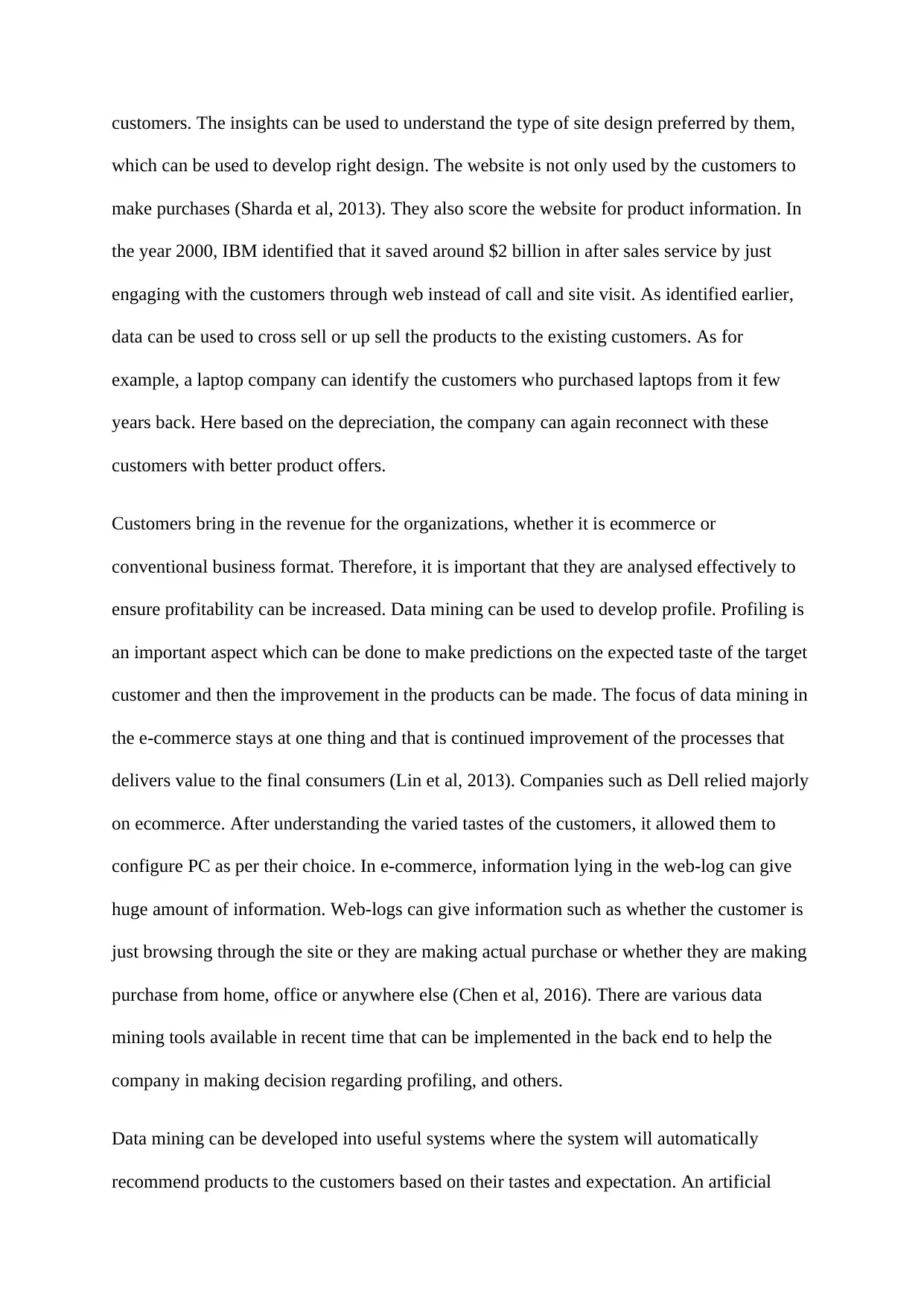
customers. The insights can be used to understand the type of site design preferred by them,
which can be used to develop right design. The website is not only used by the customers to
make purchases (Sharda et al, 2013). They also score the website for product information. In
the year 2000, IBM identified that it saved around $2 billion in after sales service by just
engaging with the customers through web instead of call and site visit. As identified earlier,
data can be used to cross sell or up sell the products to the existing customers. As for
example, a laptop company can identify the customers who purchased laptops from it few
years back. Here based on the depreciation, the company can again reconnect with these
customers with better product offers.
Customers bring in the revenue for the organizations, whether it is ecommerce or
conventional business format. Therefore, it is important that they are analysed effectively to
ensure profitability can be increased. Data mining can be used to develop profile. Profiling is
an important aspect which can be done to make predictions on the expected taste of the target
customer and then the improvement in the products can be made. The focus of data mining in
the e-commerce stays at one thing and that is continued improvement of the processes that
delivers value to the final consumers (Lin et al, 2013). Companies such as Dell relied majorly
on ecommerce. After understanding the varied tastes of the customers, it allowed them to
configure PC as per their choice. In e-commerce, information lying in the web-log can give
huge amount of information. Web-logs can give information such as whether the customer is
just browsing through the site or they are making actual purchase or whether they are making
purchase from home, office or anywhere else (Chen et al, 2016). There are various data
mining tools available in recent time that can be implemented in the back end to help the
company in making decision regarding profiling, and others.
Data mining can be developed into useful systems where the system will automatically
recommend products to the customers based on their tastes and expectation. An artificial
which can be used to develop right design. The website is not only used by the customers to
make purchases (Sharda et al, 2013). They also score the website for product information. In
the year 2000, IBM identified that it saved around $2 billion in after sales service by just
engaging with the customers through web instead of call and site visit. As identified earlier,
data can be used to cross sell or up sell the products to the existing customers. As for
example, a laptop company can identify the customers who purchased laptops from it few
years back. Here based on the depreciation, the company can again reconnect with these
customers with better product offers.
Customers bring in the revenue for the organizations, whether it is ecommerce or
conventional business format. Therefore, it is important that they are analysed effectively to
ensure profitability can be increased. Data mining can be used to develop profile. Profiling is
an important aspect which can be done to make predictions on the expected taste of the target
customer and then the improvement in the products can be made. The focus of data mining in
the e-commerce stays at one thing and that is continued improvement of the processes that
delivers value to the final consumers (Lin et al, 2013). Companies such as Dell relied majorly
on ecommerce. After understanding the varied tastes of the customers, it allowed them to
configure PC as per their choice. In e-commerce, information lying in the web-log can give
huge amount of information. Web-logs can give information such as whether the customer is
just browsing through the site or they are making actual purchase or whether they are making
purchase from home, office or anywhere else (Chen et al, 2016). There are various data
mining tools available in recent time that can be implemented in the back end to help the
company in making decision regarding profiling, and others.
Data mining can be developed into useful systems where the system will automatically
recommend products to the customers based on their tastes and expectation. An artificial
Paraphrase This Document
Need a fresh take? Get an instant paraphrase of this document with our AI Paraphraser
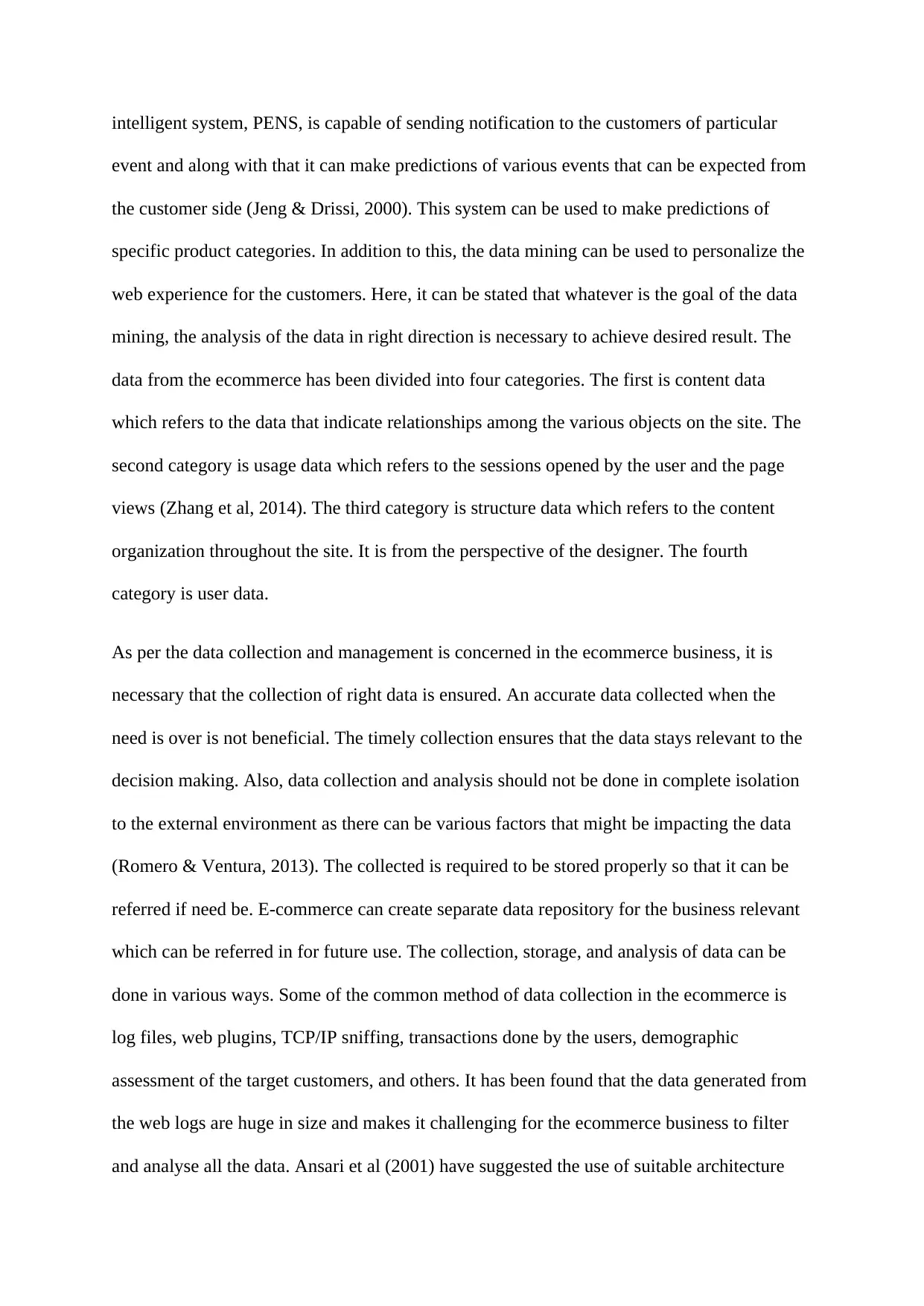
intelligent system, PENS, is capable of sending notification to the customers of particular
event and along with that it can make predictions of various events that can be expected from
the customer side (Jeng & Drissi, 2000). This system can be used to make predictions of
specific product categories. In addition to this, the data mining can be used to personalize the
web experience for the customers. Here, it can be stated that whatever is the goal of the data
mining, the analysis of the data in right direction is necessary to achieve desired result. The
data from the ecommerce has been divided into four categories. The first is content data
which refers to the data that indicate relationships among the various objects on the site. The
second category is usage data which refers to the sessions opened by the user and the page
views (Zhang et al, 2014). The third category is structure data which refers to the content
organization throughout the site. It is from the perspective of the designer. The fourth
category is user data.
As per the data collection and management is concerned in the ecommerce business, it is
necessary that the collection of right data is ensured. An accurate data collected when the
need is over is not beneficial. The timely collection ensures that the data stays relevant to the
decision making. Also, data collection and analysis should not be done in complete isolation
to the external environment as there can be various factors that might be impacting the data
(Romero & Ventura, 2013). The collected is required to be stored properly so that it can be
referred if need be. E-commerce can create separate data repository for the business relevant
which can be referred in for future use. The collection, storage, and analysis of data can be
done in various ways. Some of the common method of data collection in the ecommerce is
log files, web plugins, TCP/IP sniffing, transactions done by the users, demographic
assessment of the target customers, and others. It has been found that the data generated from
the web logs are huge in size and makes it challenging for the ecommerce business to filter
and analyse all the data. Ansari et al (2001) have suggested the use of suitable architecture
event and along with that it can make predictions of various events that can be expected from
the customer side (Jeng & Drissi, 2000). This system can be used to make predictions of
specific product categories. In addition to this, the data mining can be used to personalize the
web experience for the customers. Here, it can be stated that whatever is the goal of the data
mining, the analysis of the data in right direction is necessary to achieve desired result. The
data from the ecommerce has been divided into four categories. The first is content data
which refers to the data that indicate relationships among the various objects on the site. The
second category is usage data which refers to the sessions opened by the user and the page
views (Zhang et al, 2014). The third category is structure data which refers to the content
organization throughout the site. It is from the perspective of the designer. The fourth
category is user data.
As per the data collection and management is concerned in the ecommerce business, it is
necessary that the collection of right data is ensured. An accurate data collected when the
need is over is not beneficial. The timely collection ensures that the data stays relevant to the
decision making. Also, data collection and analysis should not be done in complete isolation
to the external environment as there can be various factors that might be impacting the data
(Romero & Ventura, 2013). The collected is required to be stored properly so that it can be
referred if need be. E-commerce can create separate data repository for the business relevant
which can be referred in for future use. The collection, storage, and analysis of data can be
done in various ways. Some of the common method of data collection in the ecommerce is
log files, web plugins, TCP/IP sniffing, transactions done by the users, demographic
assessment of the target customers, and others. It has been found that the data generated from
the web logs are huge in size and makes it challenging for the ecommerce business to filter
and analyse all the data. Ansari et al (2001) have suggested the use of suitable architecture
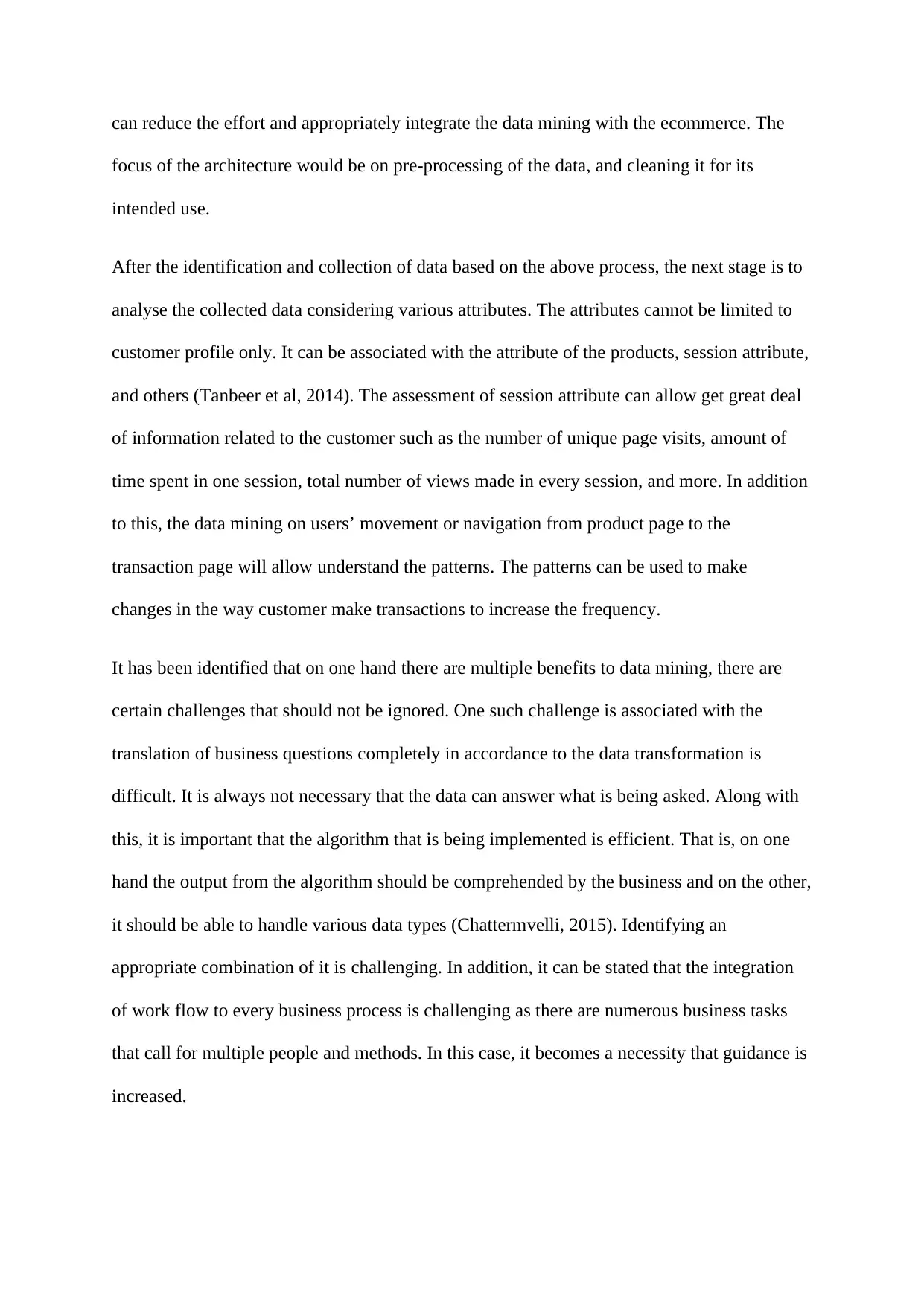
can reduce the effort and appropriately integrate the data mining with the ecommerce. The
focus of the architecture would be on pre-processing of the data, and cleaning it for its
intended use.
After the identification and collection of data based on the above process, the next stage is to
analyse the collected data considering various attributes. The attributes cannot be limited to
customer profile only. It can be associated with the attribute of the products, session attribute,
and others (Tanbeer et al, 2014). The assessment of session attribute can allow get great deal
of information related to the customer such as the number of unique page visits, amount of
time spent in one session, total number of views made in every session, and more. In addition
to this, the data mining on users’ movement or navigation from product page to the
transaction page will allow understand the patterns. The patterns can be used to make
changes in the way customer make transactions to increase the frequency.
It has been identified that on one hand there are multiple benefits to data mining, there are
certain challenges that should not be ignored. One such challenge is associated with the
translation of business questions completely in accordance to the data transformation is
difficult. It is always not necessary that the data can answer what is being asked. Along with
this, it is important that the algorithm that is being implemented is efficient. That is, on one
hand the output from the algorithm should be comprehended by the business and on the other,
it should be able to handle various data types (Chattermvelli, 2015). Identifying an
appropriate combination of it is challenging. In addition, it can be stated that the integration
of work flow to every business process is challenging as there are numerous business tasks
that call for multiple people and methods. In this case, it becomes a necessity that guidance is
increased.
focus of the architecture would be on pre-processing of the data, and cleaning it for its
intended use.
After the identification and collection of data based on the above process, the next stage is to
analyse the collected data considering various attributes. The attributes cannot be limited to
customer profile only. It can be associated with the attribute of the products, session attribute,
and others (Tanbeer et al, 2014). The assessment of session attribute can allow get great deal
of information related to the customer such as the number of unique page visits, amount of
time spent in one session, total number of views made in every session, and more. In addition
to this, the data mining on users’ movement or navigation from product page to the
transaction page will allow understand the patterns. The patterns can be used to make
changes in the way customer make transactions to increase the frequency.
It has been identified that on one hand there are multiple benefits to data mining, there are
certain challenges that should not be ignored. One such challenge is associated with the
translation of business questions completely in accordance to the data transformation is
difficult. It is always not necessary that the data can answer what is being asked. Along with
this, it is important that the algorithm that is being implemented is efficient. That is, on one
hand the output from the algorithm should be comprehended by the business and on the other,
it should be able to handle various data types (Chattermvelli, 2015). Identifying an
appropriate combination of it is challenging. In addition, it can be stated that the integration
of work flow to every business process is challenging as there are numerous business tasks
that call for multiple people and methods. In this case, it becomes a necessity that guidance is
increased.
⊘ This is a preview!⊘
Do you want full access?
Subscribe today to unlock all pages.

Trusted by 1+ million students worldwide
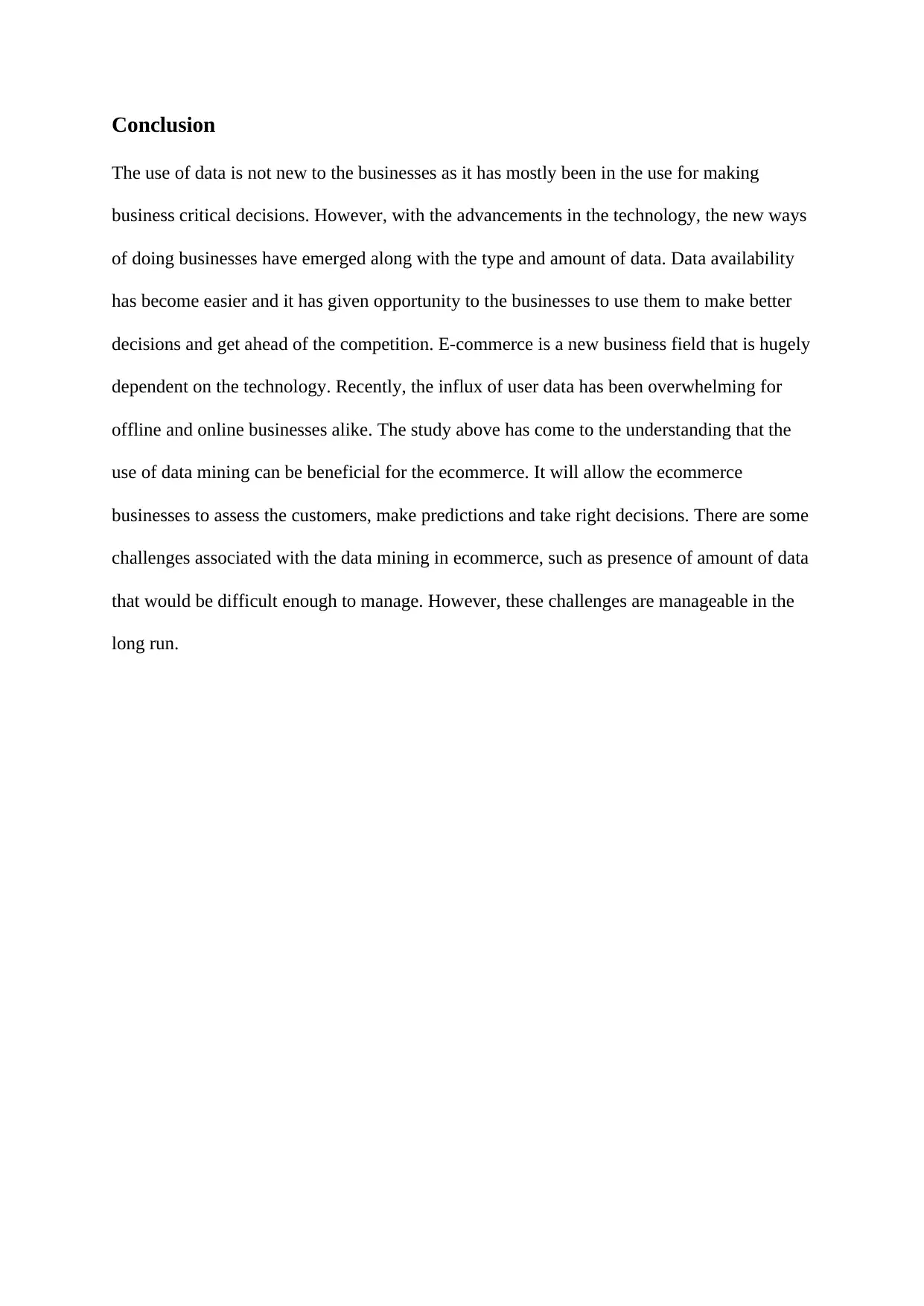
Conclusion
The use of data is not new to the businesses as it has mostly been in the use for making
business critical decisions. However, with the advancements in the technology, the new ways
of doing businesses have emerged along with the type and amount of data. Data availability
has become easier and it has given opportunity to the businesses to use them to make better
decisions and get ahead of the competition. E-commerce is a new business field that is hugely
dependent on the technology. Recently, the influx of user data has been overwhelming for
offline and online businesses alike. The study above has come to the understanding that the
use of data mining can be beneficial for the ecommerce. It will allow the ecommerce
businesses to assess the customers, make predictions and take right decisions. There are some
challenges associated with the data mining in ecommerce, such as presence of amount of data
that would be difficult enough to manage. However, these challenges are manageable in the
long run.
The use of data is not new to the businesses as it has mostly been in the use for making
business critical decisions. However, with the advancements in the technology, the new ways
of doing businesses have emerged along with the type and amount of data. Data availability
has become easier and it has given opportunity to the businesses to use them to make better
decisions and get ahead of the competition. E-commerce is a new business field that is hugely
dependent on the technology. Recently, the influx of user data has been overwhelming for
offline and online businesses alike. The study above has come to the understanding that the
use of data mining can be beneficial for the ecommerce. It will allow the ecommerce
businesses to assess the customers, make predictions and take right decisions. There are some
challenges associated with the data mining in ecommerce, such as presence of amount of data
that would be difficult enough to manage. However, these challenges are manageable in the
long run.
Paraphrase This Document
Need a fresh take? Get an instant paraphrase of this document with our AI Paraphraser
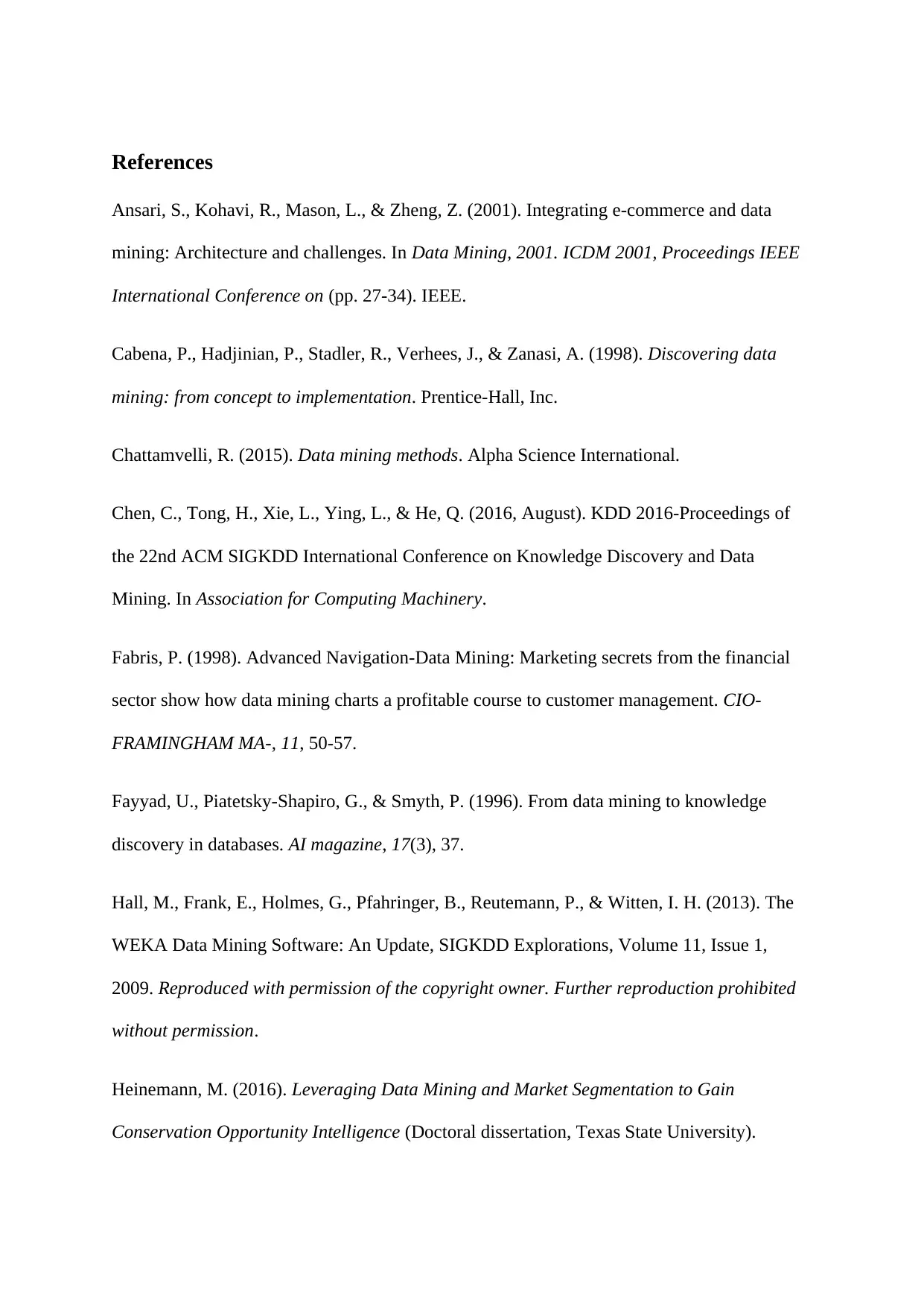
References
Ansari, S., Kohavi, R., Mason, L., & Zheng, Z. (2001). Integrating e-commerce and data
mining: Architecture and challenges. In Data Mining, 2001. ICDM 2001, Proceedings IEEE
International Conference on (pp. 27-34). IEEE.
Cabena, P., Hadjinian, P., Stadler, R., Verhees, J., & Zanasi, A. (1998). Discovering data
mining: from concept to implementation. Prentice-Hall, Inc.
Chattamvelli, R. (2015). Data mining methods. Alpha Science International.
Chen, C., Tong, H., Xie, L., Ying, L., & He, Q. (2016, August). KDD 2016-Proceedings of
the 22nd ACM SIGKDD International Conference on Knowledge Discovery and Data
Mining. In Association for Computing Machinery.
Fabris, P. (1998). Advanced Navigation-Data Mining: Marketing secrets from the financial
sector show how data mining charts a profitable course to customer management. CIO-
FRAMINGHAM MA-, 11, 50-57.
Fayyad, U., Piatetsky-Shapiro, G., & Smyth, P. (1996). From data mining to knowledge
discovery in databases. AI magazine, 17(3), 37.
Hall, M., Frank, E., Holmes, G., Pfahringer, B., Reutemann, P., & Witten, I. H. (2013). The
WEKA Data Mining Software: An Update, SIGKDD Explorations, Volume 11, Issue 1,
2009. Reproduced with permission of the copyright owner. Further reproduction prohibited
without permission.
Heinemann, M. (2016). Leveraging Data Mining and Market Segmentation to Gain
Conservation Opportunity Intelligence (Doctoral dissertation, Texas State University).
Ansari, S., Kohavi, R., Mason, L., & Zheng, Z. (2001). Integrating e-commerce and data
mining: Architecture and challenges. In Data Mining, 2001. ICDM 2001, Proceedings IEEE
International Conference on (pp. 27-34). IEEE.
Cabena, P., Hadjinian, P., Stadler, R., Verhees, J., & Zanasi, A. (1998). Discovering data
mining: from concept to implementation. Prentice-Hall, Inc.
Chattamvelli, R. (2015). Data mining methods. Alpha Science International.
Chen, C., Tong, H., Xie, L., Ying, L., & He, Q. (2016, August). KDD 2016-Proceedings of
the 22nd ACM SIGKDD International Conference on Knowledge Discovery and Data
Mining. In Association for Computing Machinery.
Fabris, P. (1998). Advanced Navigation-Data Mining: Marketing secrets from the financial
sector show how data mining charts a profitable course to customer management. CIO-
FRAMINGHAM MA-, 11, 50-57.
Fayyad, U., Piatetsky-Shapiro, G., & Smyth, P. (1996). From data mining to knowledge
discovery in databases. AI magazine, 17(3), 37.
Hall, M., Frank, E., Holmes, G., Pfahringer, B., Reutemann, P., & Witten, I. H. (2013). The
WEKA Data Mining Software: An Update, SIGKDD Explorations, Volume 11, Issue 1,
2009. Reproduced with permission of the copyright owner. Further reproduction prohibited
without permission.
Heinemann, M. (2016). Leveraging Data Mining and Market Segmentation to Gain
Conservation Opportunity Intelligence (Doctoral dissertation, Texas State University).
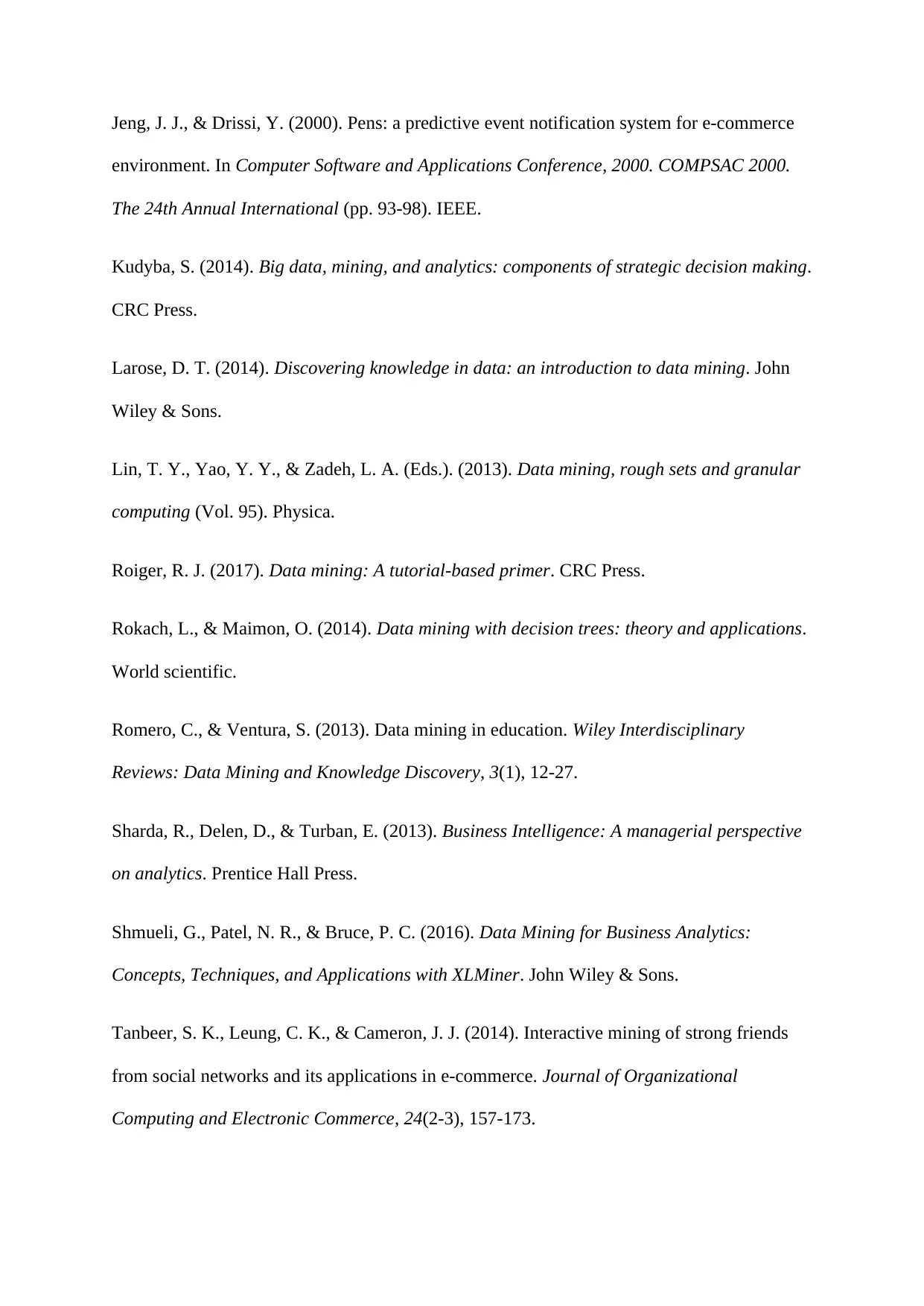
Jeng, J. J., & Drissi, Y. (2000). Pens: a predictive event notification system for e-commerce
environment. In Computer Software and Applications Conference, 2000. COMPSAC 2000.
The 24th Annual International (pp. 93-98). IEEE.
Kudyba, S. (2014). Big data, mining, and analytics: components of strategic decision making.
CRC Press.
Larose, D. T. (2014). Discovering knowledge in data: an introduction to data mining. John
Wiley & Sons.
Lin, T. Y., Yao, Y. Y., & Zadeh, L. A. (Eds.). (2013). Data mining, rough sets and granular
computing (Vol. 95). Physica.
Roiger, R. J. (2017). Data mining: A tutorial-based primer. CRC Press.
Rokach, L., & Maimon, O. (2014). Data mining with decision trees: theory and applications.
World scientific.
Romero, C., & Ventura, S. (2013). Data mining in education. Wiley Interdisciplinary
Reviews: Data Mining and Knowledge Discovery, 3(1), 12-27.
Sharda, R., Delen, D., & Turban, E. (2013). Business Intelligence: A managerial perspective
on analytics. Prentice Hall Press.
Shmueli, G., Patel, N. R., & Bruce, P. C. (2016). Data Mining for Business Analytics:
Concepts, Techniques, and Applications with XLMiner. John Wiley & Sons.
Tanbeer, S. K., Leung, C. K., & Cameron, J. J. (2014). Interactive mining of strong friends
from social networks and its applications in e-commerce. Journal of Organizational
Computing and Electronic Commerce, 24(2-3), 157-173.
environment. In Computer Software and Applications Conference, 2000. COMPSAC 2000.
The 24th Annual International (pp. 93-98). IEEE.
Kudyba, S. (2014). Big data, mining, and analytics: components of strategic decision making.
CRC Press.
Larose, D. T. (2014). Discovering knowledge in data: an introduction to data mining. John
Wiley & Sons.
Lin, T. Y., Yao, Y. Y., & Zadeh, L. A. (Eds.). (2013). Data mining, rough sets and granular
computing (Vol. 95). Physica.
Roiger, R. J. (2017). Data mining: A tutorial-based primer. CRC Press.
Rokach, L., & Maimon, O. (2014). Data mining with decision trees: theory and applications.
World scientific.
Romero, C., & Ventura, S. (2013). Data mining in education. Wiley Interdisciplinary
Reviews: Data Mining and Knowledge Discovery, 3(1), 12-27.
Sharda, R., Delen, D., & Turban, E. (2013). Business Intelligence: A managerial perspective
on analytics. Prentice Hall Press.
Shmueli, G., Patel, N. R., & Bruce, P. C. (2016). Data Mining for Business Analytics:
Concepts, Techniques, and Applications with XLMiner. John Wiley & Sons.
Tanbeer, S. K., Leung, C. K., & Cameron, J. J. (2014). Interactive mining of strong friends
from social networks and its applications in e-commerce. Journal of Organizational
Computing and Electronic Commerce, 24(2-3), 157-173.
⊘ This is a preview!⊘
Do you want full access?
Subscribe today to unlock all pages.

Trusted by 1+ million students worldwide
1 out of 13
Related Documents
Your All-in-One AI-Powered Toolkit for Academic Success.
+13062052269
info@desklib.com
Available 24*7 on WhatsApp / Email
![[object Object]](/_next/static/media/star-bottom.7253800d.svg)
Unlock your academic potential
Copyright © 2020–2025 A2Z Services. All Rights Reserved. Developed and managed by ZUCOL.




